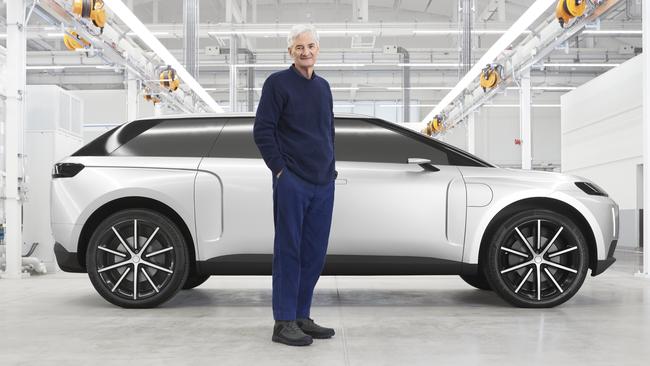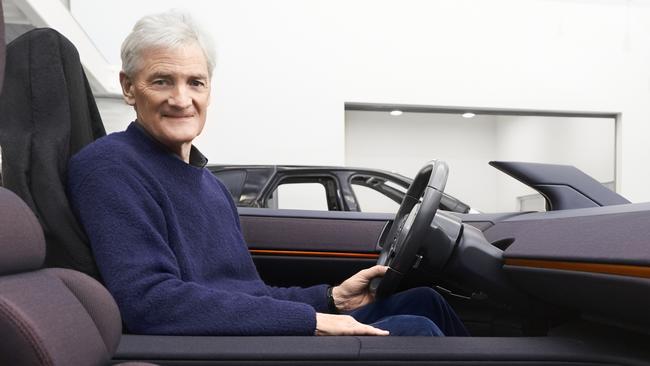James Dyson: why I pulled the plug on my electric car
He sank $940 million of his cash into a doomed electric car. But quitting was the right move, insists inventor James Dyson.

It is 11am on a spring day at Dyson’s new research centre and Britain’s best-known innovator and richest person, with an estimated fortune of £16.2 billion ($30bn), is showing off his most keenly anticipated invention. “This is the one that ran. I drove it secretly in a screened-off compound we have here,” says Sir James Dyson. Keenly anticipated, that is, until he scrapped it. He calls it N526, but to you and me it’s the Dyson car.
It’s the first time he has shown the seven-seater electric SUV with a 965km range to anyone outside his firm. It is also the first time he has confessed how devastated he is that it won’t take to the road. “There’s huge sadness and disappointment. Ours is a life of risk and of failure,” he says. “We try things and they fail. Life isn’t easy.”
Dyson, 73, has had setbacks before on his journey to the top of the rich list – he scrapped his washing machine five years after it went on sale because it cost too much to manufacture – but the car is a failure of epic proportions. Not only has he axed it before going into production, it has cost him £500m ($940m) of his own money. Dyson is a private company. It is a salutary reminder that in a world where billionaires tend to get richer in their sleep, they can still screw up royally.
It’s a shame because the car is – was – special, largely because of Dyson’s battery engineers, who have spent decades developing high-power, quiet, quick-charging cells for everything from cordless vacuums to hair straighteners. “This is the lithium ion pack that would have delivered 600 miles [965km] on a single charge,” Dyson says, proudly running his fingers over its 8500 copper cylinders. Even on a freezing winter night, on the naughty side of 100km/h on the motorway, with the heater on and the radio at full blast? “Yes, yes.”
That range was not achieved by making a light, small vehicle. The Dyson car is huge – five metres long, two metres wide and 1.7 metres tall. It weighs 2.6 tonnes, even though the body is made of aluminium. But it still looks sporty. “The windscreen rakes back more steeply than on a Ferrari,” Dyson says smiling. The wheels are bigger than on any production car on the market – almost one metre in diameter if you include the quiet-running tyres that “give low rolling resistance for economy yet excellent ride”. (He’s such a product geek, he actually talks like this).
Inside there’s room for seven adults in three rows. Round headrests give each of the seats, which are thin and firmly upholstered, the look of a lollipop. “I hate those armchair-style seats that you sink into, because there’s never enough lumbar support and you get back pain,” Dyson frowns. There are also the usual Dyson design quirks. The storage bins look like pull-out filing cabinets and all the key dashboard information – speed, sat-nav instructions – floats in front of your face like a hologram “so you never have to take your eyes off the road”.
I want one – so why can’t I, he, or anyone else have one? Money killed the car. “Electric cars are very expensive to make. The battery, battery management, electronics and cooling are much more expensive than an internal combustion engine,” he explains. It turned out that each Dyson car would have had to fetch £150,000 ($280,000) to break even, far more than electric models from the big car makers, which subsidise costs with sales of traditional petrol and diesel cars.
BMW, Mercedes, Audi and Jaguar Land Rover “are making huge losses on every electric car they sell”, he explains. “They’re doing it because it lowers their average CO2 and NO2 emissions overall, helping them to comply with EU legislation. I don’t have a fleet. I’ve got to make a profit on each car or I’d jeopardise the whole company. In the end it was too risky.”

From the day the car was announced, some critics insisted it was “a vanity project” doomed to failure. They point out that Tesla – hailed as a success by many – has burnt through $19 billion of investor cash but is still not profitable. The Dyson car “was never a goer, given the massive capital requirements”, argues Professor David Bailey of Birmingham University’s business school. “It was not a vanity project at all,” Dyson retorts. “When we started in 2014 we had good technology and a very efficient car with a long range. It was viable. But when, later, other companies started producing electric cars at a loss, it became too risky for us.”
All is not lost. Many of the 500 people working on the car have stayed on to drive research into batteries, robotics, air treatment and lighting. “The car people are a talent influx,” says Dyson. He is still investing the £2.5 billion ($4.7bn) earmarked for the car across his business in Britain and overseas, including a new research base in Singapore.
Ah, Singapore. That’s the other issue that has caused Dyson, a determined EU leaver, pain recently. When he announced 15 months ago that he was moving his firm’s head office there, it sparked accusations he was a tax-dodging Brexiteer abandoning Britain when the going got tough. He bristles at the suggestion. “We didn’t move to Singapore. There are only three or four key people there – CEO, finance, legal. We’ve grown our head count in Britain since the announcement and now have 5000 people here developing products for Europe and North America.”
So why do it? “Asia is the fastest-growing market in the world and already accounts for 50 per cent of sales. Asians love new technology, that latest thing, and absolutely ‘get’ design. If you are designing things for people in Asia, you should be in Asia. You’ve got to live it and breathe it, to think like Asians. It would be arrogant to think that we can imagine products for that market sitting here in Wiltshire. We needed to be headquartered in Asia.”
Besides, investing in Asia is what British firms should be doing post-Brexit, he says. “Let’s embrace the world, not just look to Europe. And let’s welcome talent from all over the world, not just from Europe.” All Dyson products are manufactured in Asia – in Malaysia, Singapore and the Philippines – and Dyson spends one-third of his time there.
Did the very personal criticism hurt? “A little bit. But life is like that. You can keep quiet and say nothing, then maybe you won’t get criticised in the press. But I can’t quite do that because I believe in free trade.” The row has not dimmed his optimism about Brexit. He is convinced Britain will reach a good trade deal with Brussels and reckons that countries that “have the same belief in free trade”, such as the US, Australia and Singapore, will also be very quick to do deals.
When Dyson and I last met just after the Brexit referendum, he described his post-Brexit vision of Britain as a high-skill, low-tax Singapore-style state lying off the European continent. Nothing that has happened since has changed his mind. “As a nation we don’t value engineering and science, or businesses that try to exploit those things. We can learn from Singapore. Let’s embrace education, engineering, commerce, free up planning permission and make things again.” In fact, he thinks Britain should go further than Singapore by moving to an even lower tax business model and scrapping corporation tax. How would the government make up the lost revenue? “Businesses would invest more and create more wealth and employ more people who would pay more tax.”
Many voters in the UK and US, especially young voters, have recently embraced left-wing policy platforms put forward by the likes of Jeremy Corbyn and Bernie Sanders. Both have declared that “every billionaire is a policy failure”. How does it feel to be branded a human “mistake”?
“That’s the privilege of being young, isn’t it? But it is also troubling because they’re not seeing the value of wealth creation,” he says. “You need entrepreneurs – people who make technological progress, drive things forward, create wealth for the country and employ lots of people. We’re not using government money here in Wiltshire. It’s not a government directive that we produce hand dryers, hairdryers, vacuum cleaners or air filters that use a tenth of the energy of most others and are, therefore, cheaper to run and better for the planet. We’re doing it because we believe it’s the right thing to do, because we don’t mind taking risks, don’t mind losing our money – risking our whole lives and wealth on enterprise.” Gesturing around the vast hangars of the former RAF base Hullavington, he says: “We’ve restored life to this place. These are the things that wealth creators can do.”
Will young voters change their views? “Maybe as they get a bit older. They have not understood how businesses are created, how old businesses die and new ones spring up, why exporting is important. Globalisation is not a dirty word. Developing technology is so expensive, you have to be able to sell all over the world.”
Despite scrapping the car, Dyson still thinks he can succeed in the car market by making the solid-state batteries that will power other manufacturers’ models. Solid-state cells are more energy efficient than lithium ion ones and also much smaller and lighter. They generate a lot less heat, so don’t require complex and costly cooling systems, nor do they have a nasty habit of exploding. They’re easier to recycle too.
As he walks past what would have served as the first production line for his car, Dyson says: “Other people are developing solid-state batteries. We may be the first. If what we’re doing turns out to be suitable for other people, then that’s an option.” The government wants to ban sales of all fossil fuel cars by 2035. Can this be done? “Yeah, it’s absolutely doable. In fact, 2030 is doable. I hate diesel.” Might he ever have another go at a car? “I wouldn’t say no, but the commercial circumstances would have to be right,” he says. “The garage door never closes,” he says, closing the garage door.

To join the conversation, please log in. Don't have an account? Register
Join the conversation, you are commenting as Logout